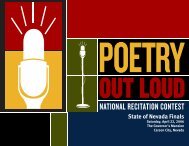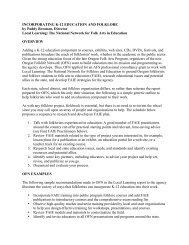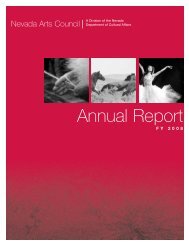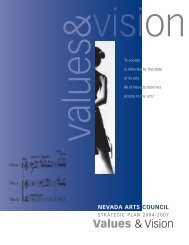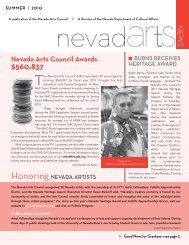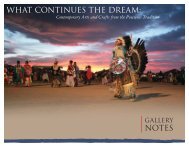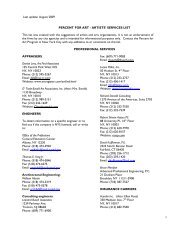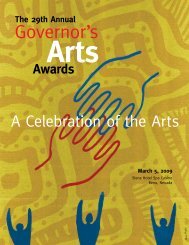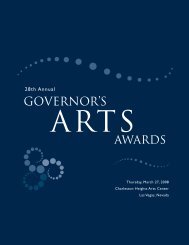Handed Down - Nevada Arts Council
Handed Down - Nevada Arts Council
Handed Down - Nevada Arts Council
Create successful ePaper yourself
Turn your PDF publications into a flip-book with our unique Google optimized e-Paper software.
1991–1992<br />
Washoe Baskets:<br />
JoAnn Martinez and Cynthia Foster<br />
The tradition of Washoe willow basketry has seen a<br />
marked resurgence in recent years, thanks in large<br />
part to the efforts of JoAnn Smokey Martinez and her<br />
sister Theresa Smokey Jackson. The two women are<br />
tireless practitioners of and advocates for the Washoe<br />
way of life, and have been extremely generous in sharing<br />
their knowledge of the language, stories, beliefs, plants,<br />
foods and crafts they grew up with.<br />
In this apprenticeship, JoAnn Martinez worked<br />
with her niece Cynthia Foster to teach the art of willow<br />
basketry. Both live in Dresslerville, the Washoe Colony<br />
near Gardnerville, and come from a long line of accomplished<br />
craftswomen. JoAnn learned to work with willows<br />
from her mother and grandmother, although she<br />
never tried making baskets on her own until she was<br />
in middle age and realized if she wanted baskets she’d<br />
have to make them herself. “It was strange there, when I<br />
started working with the willow, I knew exactly what to<br />
do, and everything just came so easily for me,” she says.<br />
“I think you have that feeling there for it, and like I say,<br />
I have a good feeling with working with willows, I just<br />
really enjoy it.”<br />
Apprentice Cynthia Foster got the same feeling, even<br />
as she struggled to learn to split willows into three parts<br />
to make threads for sewing. She raised her own children<br />
in cradleboards, but lately she had been searching for a<br />
renewed connection to her culture, and called on her<br />
family heritage to help. As she explained , “I think I just<br />
see what’s happening…I want some type of a source…<br />
and I just really felt a need, I didn’t want this to die,<br />
I didn’t want it to<br />
just disappear…<br />
so I reached back<br />
and I thought I’m<br />
going to do this, I<br />
feel artistic, I can<br />
do this, I have talent,<br />
I do, I have a<br />
desire and I have<br />
the patience.”<br />
Cynthia Foster<br />
learning to split<br />
willows.<br />
Patience is a definite prerequisite for the task, which<br />
is actually a long series of tasks. JoAnn began by showing<br />
Cynthia how to find good willows, not an easy job<br />
in the Carson Valley with its booming development and<br />
increasing use of pesticides in farming. Once gathered,<br />
willows to be used for the back of a cradleboard need to<br />
be cleaned and scraped, while willows for threads are<br />
split and the inner pith taken out; and all of this needs<br />
to be done while they are still fresh. Only when all the<br />
materials are ready can the weaving start—the long,<br />
flat back of the cradleboard, and the curved hood made<br />
from tiny willows, and decorated with yarn in different<br />
patterns for boys and girls. Cynthia completed a cradleboard<br />
during her apprenticeship, and shows every intention<br />
of continuing to develop here art with the help<br />
of her aunts.<br />
JoAnn Martinez using a winnowing tray to roast pine nuts<br />
with hot coals.<br />
20



